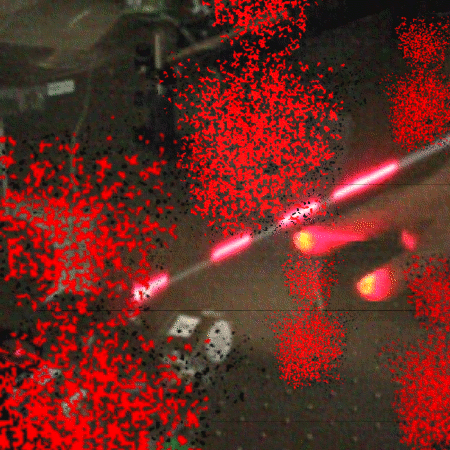tracking the dust

It is sometimes interesting to observe how ideas breed. Since some years there has been Ken Perlins vision of a Laser-Leia – or err – a teddybear? – on his marvelous and famous homepage (-> which had been included in the Whitney artport!). Seems last year his collegue Jeff Han took up Kens vision and tried to investigate the technical possibilities of the princess, and he made a video explaining the concept. However it seems things are not working yet so well, as was mentioned by Ken in an interesting video (in which Ken explains his homepage and talks about the imaginative power of children among others:-)). The concept is to find dust particles via a fast sweeping infrared laser and then to illuminate the dust particles, which are on the right place, with a visible laser in order to draw a 3D image into dusty air.
I was always asking myself whether one could also track the dust particles, once found with the infrared laser, instead of continously testing for wether there is a particle or not. I have no idea wether this makes sense (in particular in terms of computing intensity), but still this thing sticks in my head.
Alvaro Casinelli, who is also a scientist-artist hybrid (look for his famous and great work about the Khronos projector(->he won a grand prize for it!) is working on a tracking system, which looks promising to do this tracking. Well…OK lets keep on the carpet…he wrote in an email that he can currently track up to 4 things at the same time and
 Kens teddybear (to the left) needs at least a 1000 dust particles, but Alvaro also wrote that there is still MEMS integration to be made and I dont know probably he thinks also about something similar to DMDs (where however clearly the limitation in the angular separation for the target (the mirrors cant move much and usually only have two states) is in conflict with the resolution (you have to put the mirrors far away, which gives problems for the photodetectors) hoo i dont know….
Kens teddybear (to the left) needs at least a 1000 dust particles, but Alvaro also wrote that there is still MEMS integration to be made and I dont know probably he thinks also about something similar to DMDs (where however clearly the limitation in the angular separation for the target (the mirrors cant move much and usually only have two states) is in conflict with the resolution (you have to put the mirrors far away, which gives problems for the photodetectors) hoo i dont know….
addition 25th Jan. 2018:
It seems the path of a dust particle can be confined via Photophoresis to an extend that the particle appears to be trapped, as explained in this
review of the nature article “A photophoretic-trap volumetric display”. (via Sabine Hossenfelder)
So it won’t eventually take too much time until groups of particles are getting to be “trapped” in this way similar to 3D versions of this for this purpose. If this all is rather new for you Here or here some 3D nodal patterns with ultrasound (if you want to look for yourself – the patterns come also under the terms 3D Chladni figures or 3D Cymatics))…..anyways here is someone who says that these are 4D ones.
See also randform post Realtime holography.
January 26th, 2018 at 2:25 pm
Here an article by Babatunde J Falaye, Guo-Hua Sun, Muhammed S Liman, K J Oyewumi and Shi-Hai Dong about what happens if one puts a particle in a laser:
Hydrogen atom in a laser-plasma
http://iopscience.iop.org/article/10.1088/1612-2011/13/11/116003/meta